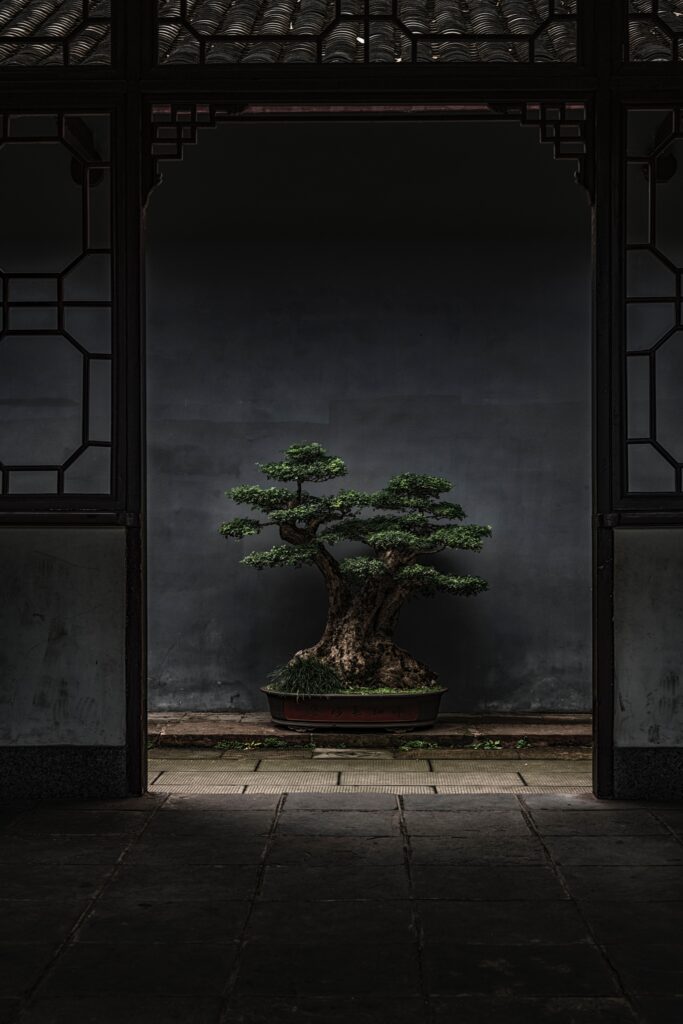
A tiny, gnarled apple tree, its trunk curved. A foot-tall banyan tree, holy as a relic.
Horror vies with love. I want one of these bonsai trees. Every leaf, every strip of bark is perfect. Enchanted, they belong to a fairy world. Each has two ages, one counted from a seedling, the other an illusion. Gardeners wire the limbs into twisted, unnatural positions, imitating a surreal dreamscape rather than nature. They amputate limbs that ruin a carefully cultivated asymmetry; they scrape bark from a trunk to create a century’s dead wood, bleaching the exposed area with lime sulphur.
A little gentle persuasion is fine. Encourage a climbing rose in a certain direction; train a pear tree to espalier along a brick wall. But bonsai is as much about artifice as about nature.
You persuade the tree that autumn has come by removing all its leaves, or you wave the leaves smaller by pruning them at the height of the growing season. You spray it with water if it ought to live in a rain forest. You make it look windswept, or as though it is growing over the edge of a cliff. You prune not only leaves but roots to stunt the growth.
No doubt I am making too much of this. I have personally wrested hundreds of unwanted saplings from the ground, their roots screaming. The bonsai have it better. Maybe I only think their existence cruel because it reminds me of foot binding, an entirely unfair comparison.
But if someone wanted to clip my hair and twist my limbs to make me look old, but promised to tend me carefully for the rest of my life? I am not sure I would agree.
“To be successful at bonsai cultivation, you must acquire the perseverance and unconditional kindness normally reserved for devout monks,” I read. Tending bonsai is a life’s work—it outlasts parenting—and it would indeed teach humility. Whenever we try too hard to control a living thing, we wind up owned by what we have endeavored to possess. We must guard it, suppress its instincts, watch over it warily, exert a constant coercive force—all while pretending that the result is a state of nature. Wires are removed before the bonsai is seen; the scar tissue from those amputations is finessed until it looks untouched by human hands.
The art of bonsai began in China at least a thousand years ago, but it took shape in Japan, influenced by Zen Buddhism’s emphasis on patience and self-discipline. Kyozo Murata, who has mastered the practice, says bonsai is more than beautiful: It reminds us that life is always changing and we are part of the passage of time, thus have no need to “dread physical waning or loneliness.”
Hard to object to that—and it makes the impulse easier to understand. We fear and hate age, and this, by proxy, brings the aging process completely under our control—and shows us death need not arrive on its heels. Bonsai trees are grown to extend their life span; they may look old, but they live almost forever. You are merely pruning so they will remain happy and healthy in a small pot. The wires can be rationalized as lending stability until the root system strengthens.
But nobody ever wired the giant redwoods for stability.
Horticulturists speak of growing bonsai as having a long, intimate conversation in which you must also listen to what the plant wants. This mollifies me, as does the tender care they receive.
“A tree that is left growing in its natural state is a crude thing,” wrote the now unknown tenth-century author of Utsubo Monogatari. “It is only when it is kept close to human beings who fashion it with loving care that its shape and style acquire the ability to move one.”
So not true.
I am drawn to these twisty, elegant little trees; they are as finely made as carved scrimshaw, or one of Queen Victorian’s shelled cameos. Yet I question the impulse to miniaturize something so majestic. I am also not sure why we needed teacup dogs and miniature horses, adorable as they all are. We lavish more care, or a certain fussy kind of care, once we miniaturize. Because we wield more control? Because the creature depends more on our protection? Shrinking something down make it seem manageable, harmless, fascinating. It makes us Gulliver, our power undisputed.
In the end, I cannot trust a love that makes a doll or a toy of the beloved, keeping it tiny and inhibiting its growth. What would the world look like, I wonder, if every single living being were free to grow as it was meant to grow? Weeds might be treated as interesting, if scraggly and invasive, plantings. Houses would be covered in ivy and Virginia creeper; yards would be dotted with wildflowers; gardens would be wilder. Poodles would look like lambs. No one would be afraid to be smart or afraid to win; imposter syndrome would vanish.
As exquisite as bonsai are, I hate what they remind me of. Art can impose itself on all the canvas or stone in the world. But it should respect nature, not turn into a living taxidermy. We have done too much destroying and called it accomplishment. And we have stunted one another, too, pruning back impulses that alarm us, squishing children into the molds we have chosen, bending the will of anyone who seems to want to grow away from us.
Done right, bonsai offer a serene beauty—to the beholder. Inside the plant, a genetic code is crashing, and a vital impulse—to grow!—still bubbles. It will die only when the plant dies. Until then, this life force must be constantly constrained. The gardener’s fight may be quiet, dignified, and artistic, but it is relentless.
Read more by Jeannette Cooperman here.
